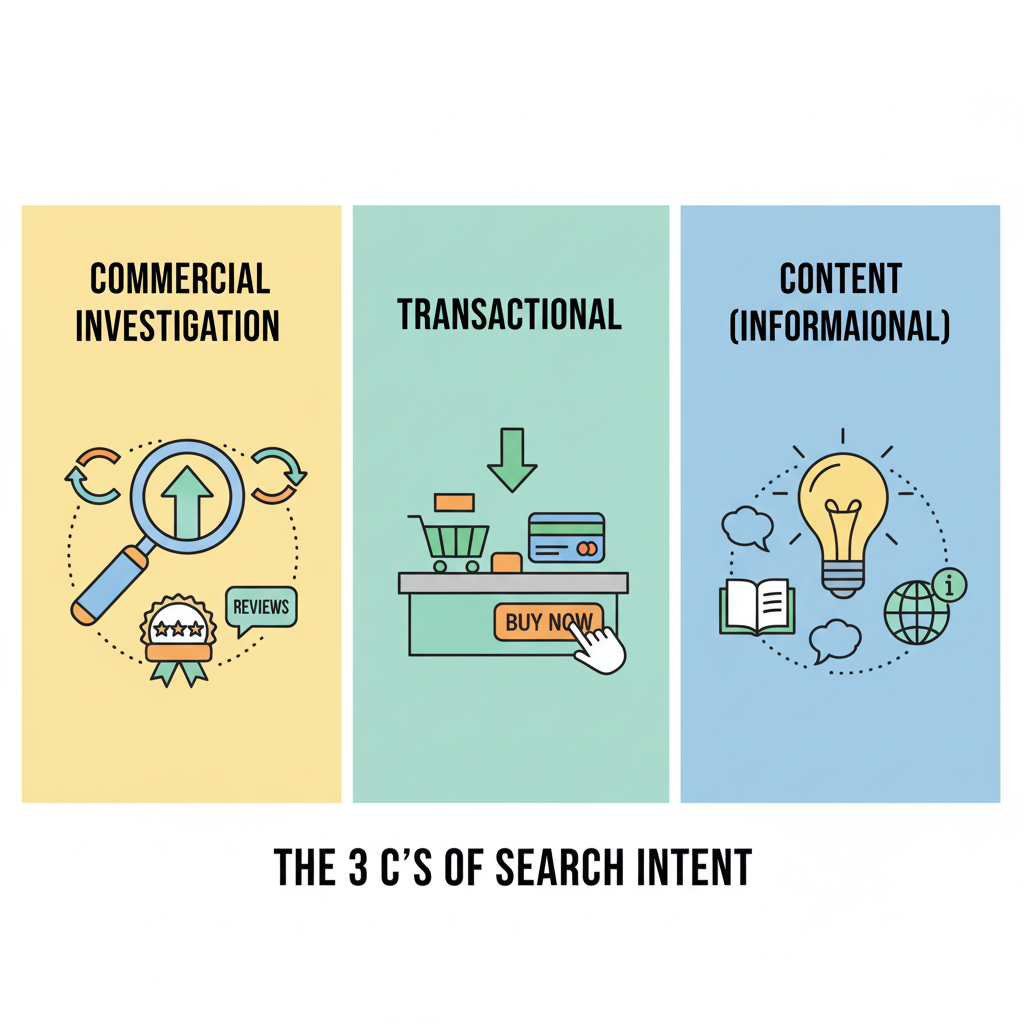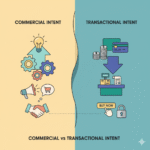Search intent is at the heart of SEO. If you don’t understand why people are searching, you’ll end up creating the wrong type of content, ranking for the wrong keywords, or worse—losing out on conversions.
That’s where the 3 C’s of search intent come in. They give you a practical framework to analyse search results and understand what Google (and users) expect to see when a keyword is typed in.
In this blog, we’ll break down:
- What search intent means
- The 3 C’s of search intent (Content type, Content format, Content angle)
- How to apply them in your SEO strategy
- Real-world examples to make it crystal clear
Let’s get into it.
First, What is Search Intent?
Search intent is simply the reason behind a search query. Every time someone types something into Google, they have a goal in mind:
- To learn something (informational intent)
- To compare or evaluate (commercial intent)
- To take action, like buying or booking (transactional intent)
- To go to a specific site (navigational intent)
Google’s algorithm is designed to match these intents with the most relevant results. That’s why if you search “how to bake a cake”, you get recipes and guides not a cake delivery service.
But understanding intent at a deeper level is where the 3 C’s help.
The 3 C’s of Search Intent
The 3 C’s are a practical way of breaking down search results so you can figure out exactly how to create content that ranks. They are:
- Content Type
- Content Format
- Content Angle
Let’s look at each in detail.
1. Content Type
This is about the kind of content that dominates the search results for a keyword.
Google doesn’t guess—it shows what most people expect to see. So, if you search a keyword and most top results are blog posts, you know users want informational content. If product pages dominate, they want to buy.
Common Content Types:
- Blog posts/articles
- Product/service pages
- Category pages
- Landing pages
- Videos
Example:
- Keyword: “best budget smartphones 2025”
- SERP shows: blog posts, reviews, and comparison guides.
- Content type = informational/commercial.
- Action: Create a blog post or comparison, not a product page.
If you get this wrong, you won’t rank. For example, trying to push a product page for a research-based keyword will fail.
2. Content Format
Once you know the type, the next step is to check the format. This tells you the structure that works best for ranking content.
Common Content Formats:
- Listicles (Top 10, Best X, etc.)
- Step-by-step guides
- Reviews/comparisons
- Opinion pieces
- Tutorials
- Landing pages
Example:
- Keyword: “how to do keyword research”
- SERP shows: step-by-step guides and tutorials.
- Content format = how-to guide.
- Action: Don’t write a listicle like “10 Tools for Keyword Research” instead, create a detailed step-by-step guide.
By aligning with the winning format, you match both Google’s expectations and the user’s mindset.
3. Content Angle
The angle is the unique perspective or focus that searchers are most interested in. It’s about answering: What specific detail or hook is drawing clicks?
Google’s results often reveal this. Look closely at headlines—do they emphasise affordability, speed, beginners, or advanced tips? That’s the angle users care about.
Common Content Angles:
- Latest year (e.g., “Best laptops 2025”)
- Price (budget, cheap, affordable, premium)
- Audience (for beginners, for small businesses, for professionals)
- Benefits (fast, easy, step-by-step)
- Comparisons (vs, alternatives)
Example:
- Keyword: “best running shoes”
- SERP shows: titles like “Best Running Shoes for Beginners 2025” and “Best Budget Running Shoes”.
- Content angle = beginner-friendly and affordable.
- Action: Shape your content around those needs, not just a generic list.
This is what separates average content from content that actually clicks with users.
Why the 3 C’s Matter
The 3 C’s are not just theory they’re about reverse-engineering Google’s results.
When you analyse the SERP with them, you learn:
- What type of content ranks (so you don’t waste time making the wrong kind).
- How to structure your content for maximum relevance.
- Which angles or hooks attract clicks and engagement.
Without this, you risk publishing content that never ranks—even if it’s high-quality.
How to Apply the 3 C’s in Your SEO Strategy
Here’s a step-by-step process you can use:
- Search your target keyword in Google.
Don’t just rely on tools look at the actual results. - Identify the dominant content type.
Is it blogs, product pages, videos? Match it. - Check the winning content format.
Are the top results listicles, guides, or reviews? Follow that structure. - Spot the common angle.
Look at the headlines and meta descriptions. Are they emphasising budget, simplicity, or latest year? - Align your content with all three.
Example: If you’re targeting “best CRM software for small business”, and results show listicles (type = blog post, format = list, angle = small business), then you know exactly how to craft your content.
Conclusion
The 3 C’s of search intent Content type, Content format, and Content angle are a practical way to decode what Google and users want.
By applying them, you move beyond keyword stuffing and start creating content that actually matches intent. And when your content matches intent, you don’t just rank you earn clicks, trust, and conversions.
Next time you plan a blog, landing page, or product description, pause and check the 3 C’s. They’ll guide you to create content that not only looks good but actually delivers results.
FAQs
Search intent is the purpose behind a user’s search query. In simple words, it’s about why someone is searching on Google. Are they looking for information, comparing products, or ready to make a purchase? Understanding this intent helps you create content that matches exactly what the searcher wants.
The four main types of search intent are:
Informational – When users want to learn something (e.g., “how to bake bread”).
Navigational – When users are trying to reach a specific site (e.g., “YouTube login”).
Commercial – When users are researching products or services before buying (e.g., “best budget smartphones 2025”).
Transactional – When users are ready to take action, like buying, booking, or downloading (e.g., “buy iPhone 15 online”).
An example would be: “best CRM software for small business”. This shows commercial intent because the user is comparing options before choosing. Another example is “buy Nike Air Zoom online”, which shows transactional intent, since the user is ready to purchase.
Searches are often grouped into three broader categories:
Informational searches – looking for knowledge or answers.
Navigational searches – trying to reach a particular brand or website.
Transactional searches – ready to complete an action like purchase, booking, or signup.
(Commercial intent is sometimes treated as part of transactional, but many SEOs separate it for clarity.)
Search intent is crucial because it ensures your content matches what users actually want. If someone searches “how to start a blog” and lands on a product checkout page, they’ll leave immediately. But if you provide a step-by-step guide, they’ll stay, engage, and trust your brand. Aligning content with search intent improves rankings, reduces bounce rates, and increases conversions.
Discover more from PratsDigital
Subscribe to get the latest posts sent to your email.


